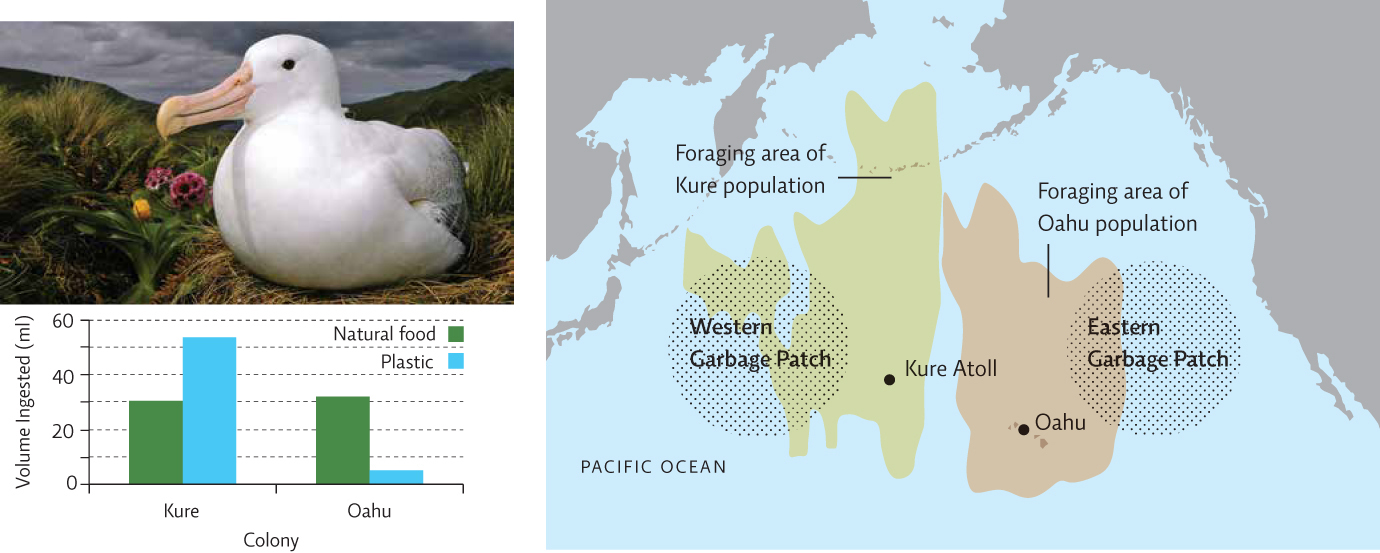17.5 Improperly handled waste threatens all living things.
The consequences of mismanaging our trash are manifold. When disposed of improperly, chemical waste can wreak havoc on plant and animal life (even some household trash is considered hazardous and should not be disposed of in a landfill or municipal incinerator); incinerators create small particle air pollution, and landfills produce methane. All of this threatens the health of ecosystems and the organisms who live there. [infographic 17.4]

305
Aquatic life is especially vulnerable. Sea mammals get tangled in everything from discarded fishing nets to plastic six-pack rings, often with fatal consequences. On top of that, many fish and nearly half of all seabirds eat plastic, often by mistake (plastic bags floating in the open ocean look a lot like jellyfish). Some of these animals choke on the plastic or are poisoned to death by its toxicity. [infographic 17.5]

Other sea animals live long enough to be consumed by predators, including humans. That’s no small matter. BPA, an organic compound used in plastic, has been shown to interfere with reproductive systems, and styrene monomers, the subunits of polystyrene, are a suspected carcinogen. Plastic also absorbs fat-soluble pollutants such as PCBs and pesticides like DDT. These toxic substances are known to accumulate in the tissue of marine organisms, biomagnify up the food chain, and find their way into the foods we eat. (For more on bioaccumulation see Chapter 3).
Researchers suspect that floating bits of plastic can also serve as an attachment point for fish eggs, barnacles, and many types of larval and juvenile organisms. Thus each tiny bit of plastic could potentially transport harmful, invasive, or exotic species to new locales. “I think one of the most underrated impacts of these so-called garbage patches is the introduction of hard surfaces to an ecosystem that naturally has very few of them,” says Miriam Goldstein, a PhD candidate at Scripps Institute of Oceanography who studies the Pacific patch. “Organisms that live on hard surfaces are very different than those that float freely in the ocean. And adding all that plastic is providing habitat that would not naturally exist out there.”

However, knowing that these things can happen is not the same as proving that they are happening in the patches. In general, as Goldstein points out, gyres tend to be areas of very low productivity, which means there are very few large fish there. It is not yet clear to scientists whether large numbers or important species of fish (or seabirds) are ingesting plastic from the gyre, or if toxic chemicals from the plastic are accumulating in their tissues.
306
On June 21st, three weeks into their journey, Proskurowski wrote on the ship’s blog:
At 0930 this morning, we sampled what I predict will be the largest amount of plastic [the program] has ever recorded in 25 years of sampling…When the tow started, I could distinctly see a few pieces in the upper layer of water and it looked like it was going to be a “good one”—one where we got enough plastic to keep the lab busy. A couple minutes into the tow, suddenly we started to see more and more macro debris—a toilet seat, white plastic bags, oil jugs, a few bread bag fasteners, Styrofoam cups, several shoes, a few foot insoles, a loofah sponge, sunscreen, and liquor bottles—sometimes appearing to form loosely organized windrows (indicative of a special type of turbulence in the upper ocean called Langmuir circulation). While everyone was commenting on all the debris, a red 5-gallon bucket drifted by the port bow with a school of about 20 fish underneath it. [The bucket got caught in the net.] Fearing the bucket would tear our net, we ended the tow early and pulled the bucket with two of its associated schools of grey triggerfish and thousands of tiny fragments of plastic on deck. [Team scientist] Skye Moret quickly dissected one fish and found 46 pieces of plastic in its guts. This school of fish, a coastal species that typically lives on reefs, was thousands of miles from land with plastic-filled stomachs.
He was right. At 23 000 pieces of plastic—more than 26 million pieces per square kilometre—the June 21st tow was the largest in the research program’s 25-year history. It would take two lab members (rotating every hour or so) more than 14 hours of continuous work to process all of it.